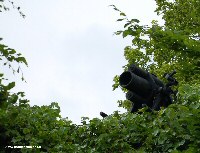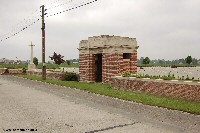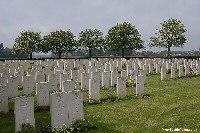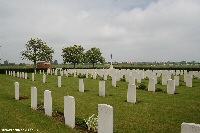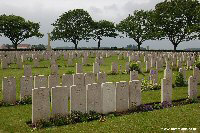Boesinghe
The World War One Battlefields site is undergoing a major update, with pages being converted to a new, user-friendly mobile format. The updated pages can be found at Updated World War One Battlefields. Some pages such as this one remain in the original format pending update.
This village (modern spelling Boezinge) is located north of Ypres reached by following the N369 out of the city. It is only a little to the east of the Ijzer canal. The area was taken over by the British in the middle of 1915; before that the French held the area. This area was the northernmost held by he British during the Great War.
In the centre of the village, to the west of the main road is one of the Demarcation Stones erected after the war. This is directly at the end of Brugstraat which leads off left from the N369.
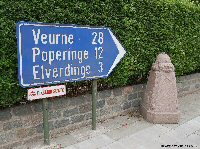
Demarcation Stone at Boesinghe
Behind the hedge tby the Demarcation Stone, set a little back, is a blockhouse which can be a little difficult to spot because of the undergrowth surrounding it. However, on the top of this, set high up, is a German mortar, known as Big Bertha.
Artillery Wood Cemetery is located east of the village, over the canal, and a short distance along the road leading towards it on a cycleway leading off to the left is a memorial to the Irish poet Francis Ledwidge. Ledwidge, serving with the 1st Royal Inniskilling Fusiliers, was one of a working party repairing the road near here when a shell exploded amongst them, killing five men and an officer. The men were buried where they fell at Carrefour de Rose (Rose Crossroads) which is just to the south of Artillery Wood Cemetery, and reinterred in the cemetery later.
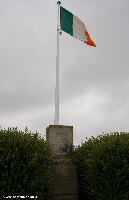
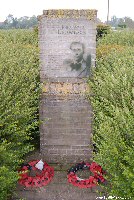
Memorial to the Irish poet Francis Ledwidge
The monument was erected by local people to commemorate the poet, and was unveiled on the 81st anniversary of his death on the 31st of July 1998. It bears the first two lines of the poem "Lament for Thomas McDonagh". A replica of the memorial stands at the museum dedicated to Ledwidge near Slane in the Boyne Valley.
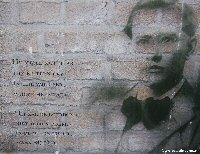
A photograph of Ledwidge and lines from one of his poems on the memorial
A little further along the road is Artillery Wood Cemetery. The cemetery was begun by the Guards Division in August 1917 after they had captured Artillery Wood itself (which was to the south-west of the cemetery) during the Battle of Pilckem Ridge. There are several Guards buried in Plot 1 who died on the 31st of July 1917. The cemetery was used until March 1918, by which time a light railway line ran right next to it, and at the Armistice there were 141 burials here. However, after the Armistice, more graves were concentrated here from a number of other cemeteries. Of the 1,307 buried or commemorated here now, 506 (or 39%) are unidentified.
One man buried here, Second Lieutenant Henry Maxwell-Stuart of the 3rd Coldstream Guards, was aged 30 when he died on the 9th of October 1917. He was one of four brothers to die serving in the Great War. Two of his brothers (Edmund and Joseph both of whom died in 1916) are also buried in Flanders, in Poperinghe New Military Cemetery and Reninghelst New Military Cemetery respectively. Another brother, Alfred, who was 20 when he died is buried in Bagneux British Cemetery in the Somme. Alfred died in August 1918, when the tide of the War was turning and perhaps his parents might have dared to hope that he might survive the war. In those days of large families, at least one other son, William, served and survived whilst the youngest son, Peter, born in 1903, was too young to serve.
Also buried here is the Irish poet Francis Ledwigde killed very near here (see above for the memorial erected to him). He is buried in Plot 2, towards the front left of the cemetery. Artillery Wood Cemetery is also the final resting place of another poet: Private Ellis Humphrey Evans, otherwise known as the poet Hedd Wyn, and also buried in Plot 2. There is a plaque attached to a wall by a crossroads near Pilkem where Hedd Wyn was mortally wounded on the 31st of July 1917. A picture of it can be seen on the Langemarck page.
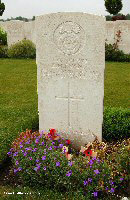
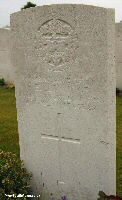
Two poets, Ellis Humphrey Evans (Hedd Wyn) and Francis Ledwidge are buried in Artillery Wood Cemetery
Occasionally in war cemeteries one comes across private memorials placed by the headstones of loved ones by families shortly after the war. For example, on the Somme at Fricourt New Military Cemetery there is a memorial scroll in stone placed in front of the grave of Lieutenant Arthur Radcliffe. Here in Artillery Wood there are two small private memorial stones placed in front of the graves of soldiers. The first is in front of the headstone of Second Lieutenant David Charles Phillips, of the 4th Royal Welsh Fusiliers. The inscription reads "2nd Lieut D C Phillips. In Loving Memory of our dear son and brother who died Aug 16 1917, we place this tablet. Mother, Father, Bessie, Herbie, Ethel, Eric. June 192-". The last digit of the year is obscured as the stone has broken there, but reading this one can imagine the family planning and preparing for their trip to Flanders. This would not have been easy in the 1920s, and they probably had the stone prepared locally (the family ran the Albion Inn in Llanelly, Carmarthenshire) and brought it with them. One can only try to imagine how they felt on finding the grave of David in this small cemetery, and the reverence with which they must have placed the stone tablet to remember him. David Phillips was 22 years old when he died.
The second private memorial can be found in the same row as the grave of Hedd Wyn. In fact, the man commemorated is another Evans; this time Private Henry Evans of the 16th Royal Welsh Fusiliers in Plot 2 F20, and the inscription is in Welsh; the translation is roughly 'Fond memories of you still in Penrhiw, Llanllwni'.
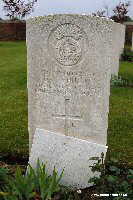
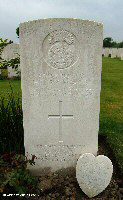
Two private memorials, to 2nd Lieutenant David Phillips (left) and Private Henry Evans in Artillery Wood Cemetery
Returning to Boesinghe and heading south towards Ypres on the main N369 road, Talana Farm Cemetery is located off the main road to the right hand side. It is signposted, and there is sufficient parking space for a couple of cars by the grass track that leads across the field to the cemetery. It is a fairly small cemetery: 529 men are buried here with only 14 of these being unidentified. Its name originates from a battle during the South African War, and there were several other farmhouses nearby which were named after battles or places in South African (such as Tugela Farm and Colenso Farm) and presumably these names were given by the Regular Army units which fought here. Talana Farm, surrounded on three sides by water, was located just to the east of where the cemetery stands, although no trace of it remains today. The path to the cemetery crosses the site of the buildings.
On the left side of the cemetery are special memorials to three men known, and three others believed to be buried here. Interestingly, the information on the CWGC website states that it is "probable that the cemetery contained other graves later destroyed by shell fire". The register can be found in a box just to the left of the entrance. There are five plots here and their slightly irregular layout shows that this is an original cemetery, and it was not added to significantly after the Armistice. The cemetery was started by French troops in April 1915 and taken over two months later by the 1st Rifle Brigade and 1st Somerset Light Infantry. In some rows the headstones are set very close together, whilst in others they are much more spaced out. The register gives some interesting information on some of the graves; for example " Buried in Plot II, Rows E and F are a number of men of the 1st East Lancashire Regiment who died in a small but successful attack on 6 July 1915. Plots III and IV contain many 49th (West Riding) Division graves and also those of the artillery units that took over the ground in August 1917."
This is a beautiful small peaceful cemetery, which although close to the main road does not suffer from its noise. As always, there are inscriptions on the headstones as you walk the rows to make you pause and reflect. For example, on the headstone of Private Albert Jewsbury of the 1st/5th West Ridings are the words 'I often think of days gone by when we were all together'.
Also by the main road, further south toward Ypres and again on the right is Bard Cottage Cemetery. This was named after a building nearby, whilst the farm that can still be seen at the end of the track next to the cemetery was known as Rivoli Farm during the war. An old photograph of the front of the cemetery can be compared with todays view below. There are twin entrance structures. The layout of the graves at the front of the cemetery is somewhat irregular, whilst those at the rear are more regular. However it is very largely an original wartime cemetery, started in June 1915 and used through until October 1918. After the Armistice 46 graves were brought into the cemetery from Marengo Farm Cemetery, which was a little to the south on the same side of the road. These graves were placed in Plot 4, Row C.
The lettering is quite weathered and hard to read on some of the headstones. However, an interesting inscription can be found on the headstone of Second Lieutenant Walter Behrens explaining that he was killed near front line whilst searching for wounded comrades. Walter served with C Battery of the 122nd Brigade of the Royal Field Artillery, and was just 20 when he died on the 10th of July 1917. The cemetery register tells us that another man, Second Lieutenant John Rawsthorne Tyrer, served originally with the 7th Manchesters but was killed in an aerial collision over Polygon Wood on the 9th of October 1917. His headstone (in Plot 5, Row A 37) lists both the Manchester Regiment and the Royal Flying Corps, as well as the emblem of the Royal Air Force (which did not come into existance until after he died). The reason for this is that after the War when headstones were being put in place, airmen who died serving with the RFC before it became the RAF were given headstones with the emblem of that later service. Over time, the CWGC plans to replace these when stones are renewed, with ones bearing the emblem of the Royal Flying Corps (which would be the case for Second Lieutenant Tyrer).
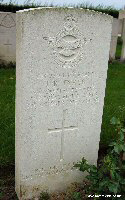
Grave of Second Lieutenant Tyrer, killed in an aerial collision over Polygon Wood
Another moving inscription can be found on the headstone of Second Lieutenant Walter Sawyer: 'Dearly loved, sadly missed. Flo Eric and Bobbie." Flo was Walter's wife, Florence, of Bridlington, and presumably Eric and Bobbie were his children. Whilst we do not yet have census information avaialbe to say how old they were, Walter himself was only 27 when he died on the 8th of October 1917.
Three men are commemorated by special memorials (two believed and one (Griffiths) known to be buried here. The register (and CWGC website) states the Special Memorial to Serjeant Arthur Griffiths is behind Plots 5 and 6, whereas in fact the three special memorials are located to the left of Plot 1. These special memorials are not marked at all on the cemetery plan. Serjeant Griffiths is recorded as having served for 24 and a half years in the South Staffordshire Regiment, and had been awarded the Long Service and Good Conduct medals. He was 44 years old, and had transferred to the 121st Company of the Labour Corps when he died on the 11th of August 1917.
Travelling further south towards Ypres, the next cemetery reached on the left is Essex Farm Cemetery, which is covered in detail by another page on the website. Another very intersting site to see near Boesinghe is the Yorkshire trench, a recreated trench system which was uncovered by The Diggers. This is dealt with on a seperate page.
Sources & Acknowledgements
Beatrix Brice: Battle Book of Ypres
Commonwealth War Graves Commission website
Great War Forum
Francis Ledwidge Centre website
Major & Mrs Holt: Battlefield Guide to the Ypres Salient
National Archives of Australia website
The Times archives

